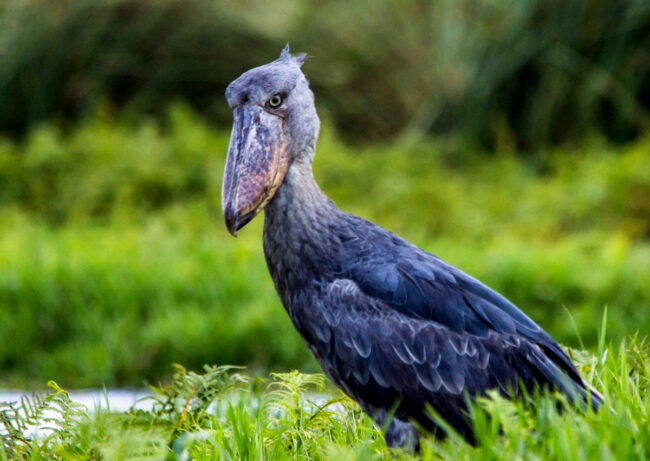Mabamba Wetland has come to be popular for viewing a Shoebill stork. Luckily, this is the most sought-after bird species by avid birders around the world. It’s therefore of no surprise that this wetland is situated on the Northwestern shoreline off Entebbe. Mabamba wetland is covered in a large scale of papyrus and other marine vegetation, which has been crucial in preserving aquatic wildlife of this area. It’s therefore classified as an Important Birding Area and Ramsar site.
Mabamba wetland is a host for more than 300 bird species and one of the major habitats in which a visitor can view about 7 of Lake Victoria’s biome restricted bird species. Some of the birds in Mabamba wetland cannot easily be viewed in other parts of the country because they are threatened. The papyrus gonolek is also a popular bird species here.
They are visible in their hundreds at this site. Palearctic bird species are in large presence, especially in the months of March up to October.
One might then wonder of how the birding is done around Mabamba wetland. There are motorized boats that are used to sail through the swampy vegetation for tourists to be able to get best view of resident birds.
Tracking the shoebill stork in Mabamba Wetland.
Shoebill storks are the most sought-after bird species in Mabamba wetland. It’s uniqueness physically and peculiar looks are some of the center attractions for it. It’s not common in many places in Uganda, save for other parts of Africa continent, which puts Uganda a better stand on attracting avid birders.
The lungfish, also known as “mamba” in Luganda language (common language spoken in Kampala) is the main food for the shoebills. Lungfish is in large quantities here, a factor that keeps these birds around the area throughout the year. They can therefore be viewed annually. Shoebills stand at a competition however, with local fishermen who equally depend on this type of fish. Nonetheless, the Shoebill Stock is still in large quantities.
The shoebill however, have not been around the area without superstition accorded to them. There had been, for generations, a superstition among fishermen around this wetland, that if a fisherman saw a shoebill on a day out for fishing, they would be destined for a sloppy fish catch on that day. Although this statement has some truth in it, because as a result of the shoebill feeding on these fish, their unsettling movements
would cause the fish to run into hiding before fishermen came for their daily activities. It created a risky stay for the shoebill because then, the fishermen started hunting them to create way for their flourished fishing industry.
As a consequence, many of these birds were killed, which drastically led to a decrease in their numbers. The result of this was to gazette Mabamba wetland as a Ramsar site in 2006 to ensure that shoebill storks are extensively protected and conserved. Birding tours have since being formalized created awareness and enlightenment within the community and phased out the superstition that was previously held. Local fishermen have also been able to make money out of birding tours, as they rent out their boats for sailing visitors across the wetland. Concerned authorities have also been supportive in educating them about resident bird species which has created employment for fishermen as possible navigators and guides.
The tide was later tuned, since presently, they rather protect the shoebill stork contrary to hunting them down like they used to do. While viewing the shoebill, tourists are advised not to get too close to them, as that may scare them off. Shoebill storks are best viewed during morning hours. The area at such time is generally calm, and this is
important because shoebills at this point are usually fishing for their lunch. They wait for the perfect time to scoop fish out of water with their bills that are modified in the shape of a shoe.
Other activities at Mabamba wetland other than birding.
Sport fishing.
Butterfly watching.
Interaction with fishermen.
Cultural expeditions.
How to get to Mabamba wetland?
Locating Mabamba isn’t a hard task altogether, since it’s close to Uganda’s main gateway (Entebbe International Airport. From Entebbe, visitors can easily drive to Nakiwogo landing site situated northwest of Entebbe. This route is the shortest. They later board a boat, which takes about 10 minutes to get across Lake Victoria and stop at Kasanje landing site. While approaching Mabamba wetland, visitors go through an open field with a considerable number of gardens that are inhabited with birds of all kind and sizes.

